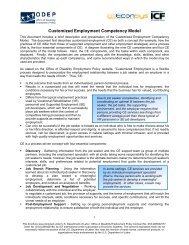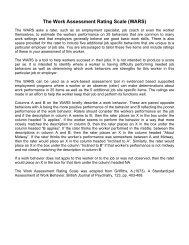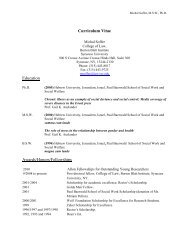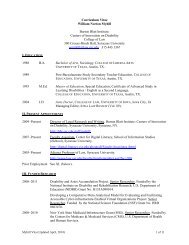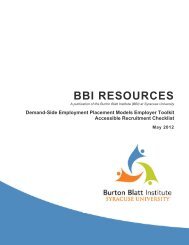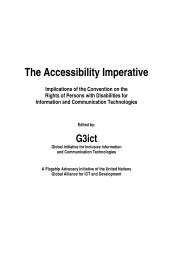Presentation
Presentation
Presentation
You also want an ePaper? Increase the reach of your titles
YUMPU automatically turns print PDFs into web optimized ePapers that Google loves.
Facilitating Recovery Through…<br />
Trauma-Informed Practices<br />
and Trauma Specific<br />
Interventions<br />
Niki Miller MS, CPS<br />
nmiller@ahpnet.com<br />
Senior Program Associate<br />
Cathy Cave<br />
ccave@ahpnet.com<br />
(N.Miller, 2011) 1
Part I -- Introduction<br />
The Big Picture in Healthcare and Behavioral<br />
Health with Regard to Trauma.
Goals of this Session<br />
►Differentiate trauma-informed from trauma<br />
specific services.<br />
►Recognize adaptive behaviors and the effects of<br />
trauma.<br />
►Learn about practices and strategies that<br />
minimize trauma responses.<br />
►Know the types of trauma-specific interventions<br />
clients can access.<br />
►Prepare yourself and co-workers to deal with the<br />
effects of working with people with trauma.<br />
3
SAMHSA’s Strategic Initiative: Trauma &<br />
Justice<br />
→Trauma-informed practices are important for all human<br />
service systems. Trauma specific services can hasten<br />
recovery for many clients.<br />
→In the absence of trauma-informed care, a trauma survivor’s<br />
path is often marked by multiple failed encounters with<br />
social services agencies.<br />
→Until it leads to the most costly of all social service systems:<br />
the Criminal Justice System.<br />
“Reducing the pervasive, harmful, and costly health impact<br />
of violence and trauma by integrating trauma-informed approaches<br />
throughout health, behavioral health, and related systems and<br />
addressing the behavioral health needs of people involved in or at<br />
risk of involvement in the criminal and juvenile justice e systems.” SAMHSA,<br />
2011
Understanding Trauma<br />
Part II
Understanding Trauma: How Traumatic<br />
Events Differ from Bad Experiences<br />
• Experienced as threat to life and limb or<br />
bodily integrity of self or someone close<br />
• Experienced as terrifying, sudden and out<br />
of the ordinary; feel helpless, hopeless and<br />
fearful.<br />
•<br />
• Extreme stress that overwhelms a<br />
person’s ability to cope<br />
(N.Miller, 2008) 6
Male and Female Responses to trauma differ:<br />
Externalize-male<br />
Internalize-female<br />
► Men tend to have more externalizing responses and women have a greater g<br />
number of internalizing responses.<br />
► Men are more likely to be exposed to violence, but less likely to develop<br />
mental health problems from exposure.<br />
► The most common traumatic experience men report is seeing someone<br />
killed or seriously injured.<br />
► Women are more likely to be sexually abused and assaulted and more likely<br />
to be victims of childhood abuse.<br />
► At least twice as likely to develop serious mental health problems as a result<br />
of trauma.<br />
(N.Miller, 2008) 7
Primal Responses to Threat<br />
Fight- hyper vigilance on conscious and<br />
unconscious levels, and flooding of physiological<br />
changes related to aggression.<br />
Flight- blood flows to the limbs preparing to run,<br />
although flight is often thwarted and there often is<br />
no relief or outlet. Avoidance, dissociation, hiding<br />
and other psychological “flight” behaviors become<br />
disruptive.<br />
Fright- responding with a state of terror, often to<br />
seemingly benign triggers; fright and anxiety<br />
permeates all areas of life. Shortness of breath,<br />
startle responses, sleeplessness.
Primal Responses to Threat<br />
Freeze- response observed in animals, accompanied by<br />
slowed and shut down metabolism. Attempt to remain<br />
safe and invisible, dissociative, paralyzed ----actually<br />
makes the survivor vulnerable. Dissociative response<br />
reinforces helplessness in each new situation.<br />
Flail- Perceived as aggression, but physical movement, such<br />
as flailing of the arms, is meant to create a safe space<br />
around the body rather than connect with a target. As<br />
when lizards, birds or fish puff up or fan out to keep<br />
aggressors from closing in.<br />
Shield- Protective, like flailing, shielding and raising hands<br />
over head and body, physiologically prepared for injury.<br />
Shielding in response to noises or non-violent conflict.
Primal Responses to Threat<br />
Flirt-Particular to women as a result of sexual violence<br />
against women, especially as children. Instinctive placating<br />
behavior for little girls sexually abused in violent homes.<br />
Incest perpetration is more likely for daughters whose<br />
fathers are violent toward the mother.<br />
Submit- Renders the victim vulnerable, but more in control.<br />
Animals will submit to predator if flight is impossible and<br />
play dead. Submission and under arousal in the face of<br />
danger. May be labeled “risk taking” behavior.
Resilience Factors that Reduce the Impact<br />
► Seeking out Support from Other People, such as Friends and<br />
Family<br />
► Finding a Support Group<br />
► Feeling Good about One’s s Own Actions in the Face of Danger<br />
► Being Able to Act and Respond Effectively despite Feeling Fear<br />
► Having a Coping Strategy, a way of getting through the event<br />
and learning from it<br />
Source: Miller, 2011
Triggers<br />
► Substantial research shows trauma symptoms and<br />
responses can increase when survivor’s begin<br />
treatment/abstinence from substances.<br />
► Triggers can become more pronounced and often are<br />
shared triggers for both trauma and drug and alcohol use.<br />
► 2/3 of men and women in addictions treatment report<br />
incidents of childhood abuse.
Triggers: Harriet<br />
“When I was on probation I had to go to a substance abuse<br />
group with a bunch of other probationers. Every week I<br />
dreaded going. Most of the time, I got high afterward. I<br />
never said anything, missed as many groups as I could,<br />
and took off the minute it was over. The counselor’s<br />
summary said I was resistant to treatment and refused to<br />
participate. I never knew why I hated it so much until I<br />
learned to identify my triggers. There was only one other<br />
woman in the group and about six guys, four of them wore<br />
leather jackets—it was the smell. When I was 15, I took<br />
off with a group of bikers to party one weekend. To make<br />
a long story short, they raped me in a field near my school.<br />
I just can’t be around the smell of leather.”
Consider What a Person Who is<br />
Homeless Has Already Survived<br />
What are they surviving now?
PART III Trauma-Related Mental<br />
Health Challenges<br />
15
Trauma-Related Mental Health<br />
Challenges<br />
►What is Post Traumatic Stress Disorder?<br />
►What are the symptoms?<br />
►What other mental health problems do<br />
survivors have?<br />
►How are they treated?<br />
16
Post-traumatic traumatic Stress Disorder<br />
Avoidance<br />
• Voluntary suppression of memory<br />
• Restriction of daily activities<br />
• Dissociation; substance use<br />
Arousal<br />
• Startle reflex<br />
• Irritability and vigilance<br />
• Sleep disturbances<br />
Intrusion<br />
• Flashbacks<br />
• Nightmares<br />
• Trauma Re-enactment<br />
enactment<br />
(N.Miller, 2008)<br />
17
Changes in Arousal, Attention,<br />
Perception and Emotion<br />
Arousal<br />
Extreme levels of excitability and responsiveness to external<br />
stimuli or numbing and detachment from the outside<br />
world.<br />
Hyper-arousal←←←→→→numbing<br />
Attention<br />
The mind’s energy is directed away from situations,<br />
completely inattentive and absent or toward them, deeply<br />
and exclusively focused.<br />
dissociation←←←→→→ hyper-focus
Changes in Arousal, Attention,<br />
Perception and Emotion<br />
Perception<br />
Pupils dilate: vision and hearing are sharpened or dulled and<br />
memory is absent<br />
heightened←←←→→→dulled<br />
Emotion<br />
Feelings are devastating and painful or inappropriately<br />
detached from experience.<br />
absent←←←→→→overwhelming
Trauma and Mental Health<br />
►Depression<br />
►Anxiety<br />
►Agoraphobia<br />
►Addiction<br />
►Personality Disorders<br />
►Dissociative Disorders<br />
20
Part IV<br />
Trauma-Informed Practices
Applying Trauma Informed Care to Human<br />
Service Settings<br />
► Universal strategies address entire groups that<br />
share the same general risk.<br />
► Universal strategies are applied to groups without<br />
any prior screening, when the entire group is<br />
capable of benefiting.<br />
► Universal assumption that trauma has occurred<br />
22
Do No Harm<br />
Trauma informed<br />
►All staff understands trauma and its impact<br />
on the recovery process.<br />
►Services have been designed to enhance<br />
safety, minimize triggers, and prevent retraumatization.<br />
►Relationships between staff and clients are<br />
based on healing and equitable distribution<br />
of power.<br />
►Trauma survivors are empowered with<br />
information, referrals, and hope.
Trauma specific<br />
Do No Harm<br />
►Clinical and program staff have specialized<br />
training in trauma treatment and recovery<br />
practices.<br />
►Specific groups and interventions are aimed<br />
at reducing effects of trauma and increasing<br />
knowledge and coping skills<br />
►Skills development empowers survivors to<br />
manage the aftermath of victimization and<br />
trauma.
Four Principles for Homeless Services<br />
(Hopper, Bassuk & Olivet, 2010)<br />
1.Trauma Awareness- training and education,<br />
practice based in theory, expertise and research;<br />
staff development<br />
2. Emphasis on Safety- physical and emotional<br />
safety, predictability, consistent boundaries,<br />
respect, culturally responsive, minimizes re-<br />
traumatization, , healing relationships<br />
25
Four Principles (Hopper, Bassuk & Olivet, 2010)<br />
3. Choice and Control- minimizes power<br />
imbalances, involves consumers in service<br />
design, delivery and evaluation, empowerment<br />
model<br />
4. Strength-based and Empowering- focus on<br />
resiliency, recognizes adaptive behaviors as<br />
survival skills, recognizes and builds on<br />
strengths, instills hope<br />
26
Trauma-Informed Environment's<br />
► Creating safety is primary; the safer and more predictable the<br />
service environment, the better the engagement.<br />
► Services have been designed to enhance safety, minimize<br />
triggers, and prevent re-traumatization<br />
traumatization.<br />
► Education and information about trauma and recovery is<br />
incorporated into services delivery.<br />
► All staff understands trauma and its impact on the recovery<br />
process, relationships, and on staff’s s effectiveness.<br />
► Power-sharing is the basis of helping relationships that are<br />
founded on respect, information, connection and hope.
Trauma-Informed Services<br />
Staff Training<br />
Consumer/Survivor Education<br />
Reducing Triggers<br />
Dealing with Unavoidable Triggers<br />
Calming, Grounding and De-escalation<br />
Present-day Focus on Symptoms<br />
Support for self awareness and self care<br />
Peer Support
Foundations of Trauma-Informed Care<br />
► Principles of trauma-informed care see substance use and<br />
other behavioral health problems as adaptive responses to<br />
trauma.<br />
► The assumption of a trauma history guides every<br />
encounter, at every level of care, whether or not clients<br />
disclose or even remember trauma.<br />
► Responses and defense mechanisms are reframed as<br />
survival strategies that served a safety function and are<br />
recognized as evidence of strength.<br />
► The goal is to empower survivors with knowledge and skills<br />
so they can take care if themselves, feel a sense of choice,<br />
internal control and autonomy.
Screening—assume a trauma history, but<br />
always screen for current safety.<br />
If screening for past trauma, then guidelines are<br />
helpful.<br />
► Wait to screen after the person has adjusted<br />
rather than upon admission<br />
► Explain the screening in advance, how the<br />
information will be used to benefit him or her,<br />
then ask if you can continue.<br />
► Use valid screening tools that focus on presentday<br />
symptoms. Use a checklist when asking about<br />
past abuse rather than an interview.
Screening—assume a trauma history, but<br />
always screen for current safety.<br />
► Tell them that yes or no answers are fine unless<br />
they wish to say more.<br />
► Give her or him as much control as possible,<br />
including passing on questions, taking breaks etc.<br />
and choosing the setting.<br />
► If the client becomes too upset, redirect by talking<br />
about their strengths, the present day, and ask<br />
them to talk about how they have gotten through.<br />
Trauma screening tools can be found at the<br />
National Center for PTSD.
Trauma Stabilization and Psycho-Education<br />
► Grounding—directing attention to the “here-andnow”<br />
and away from sensory recall of the past,<br />
negative experiences, and emotional states.<br />
► Self-soothing—preparing a menu of comforting<br />
and calming procedures in advance of a response<br />
that they can use when emotions become<br />
dysregulated and arousal is high.<br />
► Self-care—learning to self-monitor emotional<br />
states, evaluate choices and actions, and actively<br />
pursues emotional, mental, and physical healing.
The Institute for Health and Recovery has<br />
created a safety tool to help trauma survivors<br />
use calming strategies to cope with triggers.<br />
Work with people to answer the<br />
following questions:<br />
►What are your triggers?<br />
►What are your early warning signs?<br />
►How do you know that you are becoming<br />
emotionally overwhelmed?<br />
►What helps you calm down when you are<br />
upset?<br />
►What can staff members do to help at those<br />
times?
PEACE is an acronym for one approach<br />
to cope with unavoidable triggers:<br />
►<br />
►<br />
►<br />
►<br />
►<br />
Predict and prepare—“When we go to court, your husband will be in the<br />
room. Tell me what steps would make you feel safest in court?...What would<br />
you like to do to take care of yourself afterward?”<br />
Enlist—“What has helped you in the past not to drink when you had to deal<br />
with your mother yelling at your kids?”<br />
Acknowledge—“Many women have a difficult time when we have to give a<br />
urine sample—it feels invasive. I can understand why it makes you anxious.”<br />
Choice and control—“We have to go through everyone’s belongings to make<br />
sure nothing unsafe comes into the facility…would you like to be in the room<br />
when I check yours or should I do it while you are with the nurse?”<br />
Explain—“We ask each person to go through the metal detector to check for<br />
anything unsafe that might come into the building. If you turn your back<br />
toward me I won’t have to reach around you. I will need to run this wand<br />
alongside you. Would you mind putting your arms out?” (Miller, 2010)
PERCEPTION TRIAD<br />
►Non-intervening<br />
witness<br />
►Enlightened<br />
witness<br />
Abuser<br />
Rescuer<br />
Victim<br />
(N.Miller, 2008) 35
The RICH Model<br />
(From Risking Connections- Sidran Press)<br />
► Respect—this may be a very different response than expected. It can<br />
be challenging to convey respect consistently. Survivors may view<br />
staff as authority figures or through the lens of past abuse.<br />
► Information—let everyone know what is going to happen and why.<br />
Education on the relationship between trauma and substance use and<br />
how others have successfully overcome the effects of trauma.<br />
► Connection—with the here-and-now and senses, connections with<br />
people, and internal connections; between the mind, body and spirit,<br />
between actions and values. Safe connections with others re-write the<br />
patterns of abuse within relationships and ground survivors in today.<br />
► Hope—remind survivors of their many strengths; that they have<br />
survived many things; recount their recent successes, small victories<br />
and strengths. The successes of others in recovery helps sustain hope<br />
for staff and clients alike.
Trauma Informed Peer Support<br />
Fundamentals<br />
►Peer Support is rooted in:<br />
• A natural human response to shared<br />
adversity<br />
• The desire for healing & growth<br />
• Compassion for self and others<br />
• Consciousness-raising
Peer Support Principles<br />
Regardless of the setting or type of<br />
activity, peer support is based on<br />
the following principles:<br />
►Voluntary<br />
►Non-judgmental<br />
►Respectful<br />
►Reciprocal<br />
►Empathetic
Peer Support is NOT<br />
►A “program model”<br />
►Focused on diagnoses or deficits<br />
►About “helping” others in a hierarchical way<br />
►Being a “counselor”<br />
►Pressuring people to comply with treatment<br />
►Monitoring people’s behavior
Peer Support Fundamentals<br />
Peer support promotes growth and<br />
healing through:<br />
• Building reciprocal relationships among a<br />
community of equals<br />
• Learning from each other<br />
• Taking action
Trauma Recovery<br />
► Recovery from trauma encompasses multiple aspects of<br />
people lives, involves changing deep-seated beliefs and<br />
gaining knowledge and skills that restore a sense of<br />
choice and control.<br />
► The assumption of a trauma history guides every<br />
encounter, whether or not clients screen for, disclose or<br />
even remember trauma and whether or not trauma<br />
treatments are available.<br />
► Responses and defense mechanisms are reframed as<br />
survival strategies that served a safety function and are<br />
seen as evidence of strength and resiliency.<br />
► EXERCISE # 1
PART V<br />
Trauma Specific Interventions<br />
42
Trauma Treatment and Recovery<br />
Treatment types<br />
►Pharmacological<br />
►Physiologically<br />
►Past based<br />
►Present based<br />
(N.Miller, 2008) 43
60% of people with PTSD<br />
improve with manualized<br />
present day, symptom based<br />
treatment.<br />
Najavits, , 2007<br />
(N.Miller, 2008) 44
Tasks of Trauma Recovery<br />
Judith Herman (1992) identified three stages of recovery from trauma:<br />
► Gain authority over the memory<br />
► Safety<br />
► Self-soothing<br />
► Grounding<br />
► Self-regulation/affect regulation<br />
► Identification and elimination of triggers<br />
► Grieving<br />
► Empowerment
The Trauma Conversation, Redirecting<br />
and Giving Voice<br />
►Silencing those who have found the<br />
courage to speak is as re-traumatizing as<br />
delving and probing. Perpetrators of abuse<br />
attempt to keep their victims silent.<br />
However, if staff is spending a great deal of<br />
time in discussion of the details of the past<br />
abuse, it will take a toll.<br />
►Modeling safe language to name<br />
experiences and teaching boundaries in the<br />
area of self-disclosure is also helpful.
The Trauma Conversation, Redirecting<br />
and Giving Voice<br />
►It is crucial to educate about trauma:<br />
intrusion, the power of sensory recall, and<br />
vicarious trauma. This is as important to<br />
client self-care as it is to preventing<br />
compassion fatigue among staff.<br />
►Rules of thumb: allow clients to take the<br />
lead on conversations, do not probe or<br />
silence. Master simple re-directing<br />
techniques , encourage self-soothing or<br />
grounding if there is distress.
Manualized Treatments for Integrating Trauma Recovery<br />
See Handout: Trauma-specific interventions with educational<br />
components, that teach coping skills.<br />
►Seeking Safety<br />
►Essence of Being Real<br />
►Trauma, Addiction, Mental Health, and Recovery<br />
(TAMAR)<br />
►Trauma Recovery & Empowerment Model (TREM)<br />
►Addiction & Trauma Recovery Integration Model<br />
(ATRIUM)<br />
►Trauma Affect Regulation: Guide for<br />
Education & Therapy (TARGET)<br />
48
Women, Children and Sexual & Domestic<br />
Violence<br />
Trauma is devastatingly interpersonal for women<br />
and children. It involves violations that are tragically<br />
intimate or the threat of lethal violence from a loved<br />
one. Betrayal accompanies these types of traumatic<br />
experiences. They are the most likely to result in<br />
serious mental health problems and a drastic<br />
alteration in one’s assumptions about the world.<br />
49
Thank you for bringing so many people home.<br />
However, these types of events are NOT mental health<br />
problems in and of themselves; they are crimes. And<br />
sometimes justice is as healing and necessary as<br />
counseling. And it is only just that human service<br />
systems become trauma-informed, gender responsive<br />
and culturally aligned. When gender and race intersect<br />
with economic and health disparities, and vulnerability<br />
to violent and sexual victimization is the result, justice<br />
must be part of the answer.<br />
SELF ASSESSMENT EXERCISE # 2 50
.<br />
References<br />
Ashley, O., Marsden, M. E., & Brady, T. M. (2003). Effectiveness of substance abuse treatment programming for women: A review.<br />
American Journal of Drug and Alcohol Abuse, 29, 19-53.<br />
Beck, A. (2000). Prison and jail inmates at midyear 2000. Bureau of Justice Statistics Bulletin. Washington, DC: U.S. Department of<br />
Justice, Bureau of Justice Statistics.<br />
Bennett & Lawson, 1994; Miller, Downs, & Gondoli, 1989; Stark & Flitcraft, 1996 as cited in Safety and Sobriety: Best Practices in<br />
Domestic Violence and Substance Abuse. Domestic Violence/Substance Taskforce of Ill.DHHS.<br />
Center for Substance Abuse Treatment. (1997).Substance Abuse and Domestic Violence. Treatment Improvement Protocal. US DHHS.<br />
Chase, K.A., O’Farrell, T. J., Murphy, C. M., Fals-Steward, W., and Murphy. M. (2003). Factors associated with partner violence among<br />
female alcoholic patients and their male partners. Journal of Studies on Alcohol, 64, 137-149.<br />
Clark, H. W. (2001). Residential substance abuse treatment for pregnant and postpartum women and their children: Treatment and<br />
policy implications. Child Welfare League of America 0009-4021/2001/020179.<br />
Council of State Governments. (2005). Violence against women with mental illness. Consensus Project. Justice Center of the Council of<br />
State Governments.<br />
Drapkin, M. , McCrady, B., Swingle, J.M. and Epstein, E.(2005). Exploring bidirectional couple violence in a clinical sample of female<br />
alcoholics. Journal of Studies on Alcohol, March 2005, 213-219.<br />
Easton, C. J., Swan S. and Sinha, , R. (2000) Prevalence of family violence in clients entering substance abuse treatment. Journal of<br />
Substance Abuse and Treatment 18, 23–28<br />
28<br />
Farley, M., Golding, J.M., Young, G., Mulligan, M. and Minkoff, , J.R. (2004). Trauma history and relapse probability among patients<br />
seeking substance abuse treatment. Journal of Substance Abuse Treatment, T<br />
27, 161-167.<br />
167.<br />
Finkelstein, N., VanDeMark, , N., Fallot, , R., Brown, V., Cadiz, S. & Heckman, J. (2004). Enhancing substance abuse recovery through<br />
integrated trauma treatment. Sarasota, FL: National Trauma Consortium.<br />
Felitti, , V. The relationship of adverse childhood experiences to adult health: Gold in to lead." The Permanente Journal/ Winter 2002/<br />
Volume 6 No. 1<br />
Gillece,J. . ( 2001) Understanding the Prevalence and Effect of Trauma in the t<br />
Lives of Those in Our Care to Presented by Joan Gillece,<br />
Ph.D. National Association of State Mental Health Program Directors, National Technical Assistance Center
Harris, M., & Fallot, R. D. (2001). Using Trauma Theory to Design Service Systems. San Francisco: Jossey-Bass.<br />
Herman, J (1992). Trauma and Recovery. NY, NY: Basic Books<br />
Hopper, E., Bassuk, E. and Olivet, J. (2010). Shelter from the Storm: Trauma-Informed Care in Homelessness Services Settings. The Open Health<br />
Services and Policy Journal, 2010, 3, 80-100.<br />
Islam-Zwart, K. A., & Vik, P.W. (2004). Female adjustment to incarceration as influenced by sexual assault history. Criminal Justice and Behavior, 31,<br />
521-541 Van der Kolk, B. A., McFarlane, A.C. and Weisaeth, L. (Eds). Traumatic Stress: The Effects of Overwhelming Experiences on Mind, Body, and<br />
Society. (1996). New York, N.Y.: Guilford Press<br />
Miller, N. (2009). Trauma informed Offender Management. Police Standards and Training Academy. Concord, NH.<br />
Miller, N. and Najavits, L.(2011). Trauman-informed correctional care (in press). European Journal of Psychotraumatology.<br />
Najavits, L.M., Weiss, R.D., & Shaw, S.R. (1997). The link between substance abuse and post-traumatic stress disorder in women: A research review.<br />
American Journal on Addictions, 6, 273-283.<br />
Ouimette, P., Finney, J.W., and Moos, R.H. (1999). Two-year posttreatment functioning and coping of substance abuse patients with posttraumatic stress<br />
disorder. Psychology of Addictive Behaviors, 13(2), 105-114.7.<br />
Saakvitne and Pearlman (1996)Transforming the Pain: A Workbook on Vicarious Traumatization p. 71)<br />
Suris, A., Lind, L. (2008). Military Sexual Trauma: Review of Prevalence and Associated Health Consequences in Women Veterans. Trauma, Violence, and<br />
Abuse: A Review Journal,9: 250-269<br />
Suzanne Swan, PhD, Stephanie Farber, PhD, and Donna Campbell, LCSW. Violence in the Lives of Women in Substance Abuse Treatment: Service and<br />
Policy Implications: http://www.womensconsortium.org/pdf/swan001025.pdf<br />
University of Cincinnati's School of Social Work—findings from the Cincinnati study presented at the 10th International Conference on Family Violence in<br />
San Diego in September.<br />
Vogeltanz, N. D., Wilsnack, S. C., Harris, T. R., et al. (1999). Prevalence and risk factors for childhood sexual abuse in women: national survey findings.<br />
Child Abuse & Neglect, 23, 579-592.<br />
Warren, J. I., Hurt, S., Loper, A. B., Bale, R., Friend, R., & Chauhan, P. (2002). Psychiatric symptoms, history of victimization, and violent behavior among 52<br />
incarcerated female felons: An American perspective. International Journal of Law and Psychiatry, 25, 129-149.




